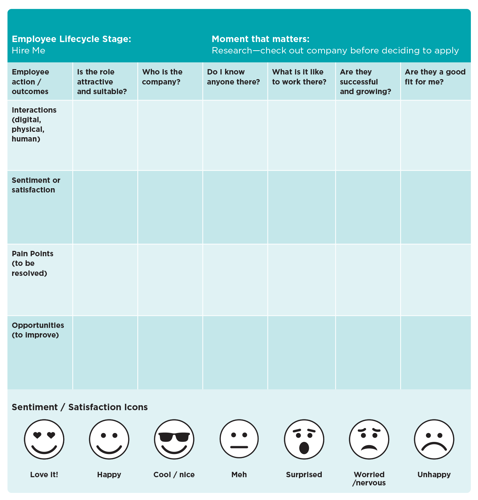What are Employee Journey Maps?
The Employee Lifecycle is made up of several stages and each of these stages can include a number of Employee Journeys. In order to minimise the complexity of journey mapping, we advise to try to be as granular as possible, for example, focusing on the first day Employee Journey as part of the overall onboarding experience. It is really about breaking stages down into manageable chunks. Whichever area you choose, the next step will be to map that element of the Employee Lifecycle in more detail.
Before we can truly understand how to improve an Employee Journey, we need to understand the current situation, so it is important to map the current Employee Journey in detail first. Journey mapping allows us to create a visual representation of an employee’s experience at that point in their Employee Lifecycle, and would normally be created during a workshop that would be facilitated by the EX team and involve a relevant group of employees who have experienced that particular journey. So, using the first day example, you would have members of the core Employee Experience (EX) team involved in the workshop, as well as people from Talent Attraction, Onboarding, L&D, and some people who have recently just had their first day. As we often say, it’s the people who actually do the work who know it best.
Too often, employee journeys are ‘pass the parcel’. A person or a team do their bit, then it’s over to another. This can make the experience disjointed and often conflicting information is given. This is why it’s important to have a core team, so they can follow ‘the parcel’ from one activity to the next and ensure continuity.
When considering Employee Journey Mapping, it’s worth ensuring these things are discussed:
- Which part of the Employee Lifecycle needs the most urgent attention?
- What’s the goal?
- How can we keep the employee in mind?
- Can you match employees’ wants, needs and expectations?
- What can we do swiftly and what may take time?
- What can we do for no/low cost, and what requires budget?
- Are we being too ambitious in terms of size/scope? (Does it need breaking down even more?)
- What evidence do we have on this journey?
- Do we need more?

When discussing Employee Journeys, it’s recommended to use ‘I’ and really put yourself into the employee’s shoes. E.g. On my first day, I would like all my tech to be ready.
Employee Journey Maps should be used in conjunction with Employee Archetypes, Empathy Maps and Stop Start Change Continue canvases.
Do get in touch with us if you’d like to know more about Employee Journey maps.
For more on Employee Experience frameworks, view this page.

Here at Comma, our network of IC, HR and employee engagement specialists were keen to understand what EX is all about and the potential career path into it. With Nicholas being a leading voice in EX and co-author of one of the most popular books in this space, we knew he’d lead a brilliant session for us in 2023 – and he did. If you’re an organisation investing in EX, I’d highly recommend a conversation with Nicholas.

